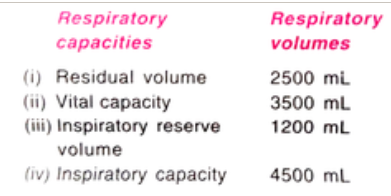The quantity 1500 mL in the respiratory volumes of a normal human adult refers to
maximum ari that can be breathed in and breathed out
residual volume
expriatory reserve volume
Total lung capacity minus residual volume
The correct Answer is:B
Residual air is the volume of air that remains in the lungs after the most forcelfu expiration .It equal s to 1500 mL .Resdual air mostly occurs in alveoli
Maximum air that can be breathed in and breathed that ocan be expird over and above the tidal air by most forceful expirationn is the expiratiory reserve volume (1200 mL).
Topper's Solved these Questions
Similar Questions
The quantity 1100-1200mL in the respiratory volumes of a normal human adult refers to
View Solutionlisted below are four respiratory capacities (A-D) and four jumbled respiratory volumes of a normal human adult
Respiratory capacities− Respiratory volumesResidual volume− 2500 mLVital capacit− 3500 mLInspiratory reserve volume− 1200mLInspiratory capacity− 4500mL
Which one of the following is the correct matching of two capacities and volumes
View Solution
Knowledge Check
listed below are four respiratory capacities (A-D) and four jumbled respiratory volumes of a normal human adult
Respiratory capacities− Respiratory volumesResidual volume− 2500 mLVital capacit− 3500 mLInspiratory reserve volume− 1200mLInspiratory capacity− 4500mL
Which one of the following is the correct matching of two capacities and volumesA(A) 4500 mL, (B) 3500 mLB(B) 2500 mL, (C )4500 mLC(C ) 1200 mL, (D) 2500 mLD(D) 3500 mL, (A) 1200 mLListed below are four respiratory capacities (a-d) and four Jumbled respiratory volumes of a normal human adult.

Which one is a correct matching ?A(c) 1200 mL, (d) 2500 mLB(d) 3500 mL, (a) 1200 mLC(a) 4500 mL, (b) 3500 mLD(b) 2500 mL, (c) 4500 mLListed below are four respiratory capacities (i-iv) and four jumpled respiratiory volumes of a normal human adult.
Respiratory volumes and capacitiesVolume of air(i)Residual volume1200 mL(ii)Vital capacity4500 mL(iii)Inspiratory reserve volume2500 mL(iv)Inspiratory capacity3500 mLA(ii) - (a), (iii) - (d)B(iii) - (c), (iv) - (a)C(iv) - (b), (i) - (c)D(i) - (d), (ii) - (b)
Listed below are four respriatory capacities (i-iv) and four jumbled respiratory volumes of a normal human adult

View SolutionListed below are four respiratory capacities (i-iv) and four jumpled respiratiory volumes of a normal human adult.
Respiratory volumes and capacitiesVolume of air(i)Residual volume1200 mL(ii)Vital capacity4500 mL(iii)Inspiratory reserve volume2500 mL(iv)Inspiratory capacity3500 mL
View SolutionListed below are four respiratory capacities (i-iv) and four jumpled respiratiory volumes of a normal human adult.
Respiratory volumes and capacitiesVolume of air(i)Residual volume1200 mL(ii)Vital capacity4500 mL(iii)Inspiratory reserve volume2500 mL(iv)Inspiratory capacity3500 mL
View SolutionBP of a normal adult is
View SolutionHow many phalanges are present in a normal human adult?
View Solution
